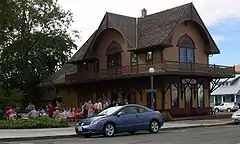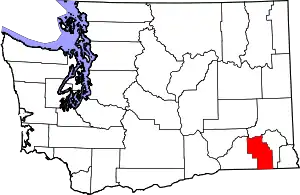Dayton, Washington
Dayton is a city in and the county seat of Columbia County, Washington, United States.[5] The population was 2,526 at the 2010 census.
Dayton | |
|---|---|
| Dayton, Washington | |
 Columbia County Courthouse in Dayton | |
 Location of Dayton, Washington | |
| Coordinates: 46°19′11″N 117°58′40″W | |
| Country | United States |
| State | Washington |
| County | Columbia |
| Area | |
| • Total | 1.44 sq mi (3.73 km2) |
| • Land | 1.44 sq mi (3.73 km2) |
| • Water | 0.00 sq mi (0.00 km2) |
| Elevation | 1,660 ft (506 m) |
| Population | |
| • Total | 2,526 |
| • Estimate (2019)[3] | 2,442 |
| • Density | 1,694.66/sq mi (654.48/km2) |
| Time zone | UTC−8 (Pacific (PST)) |
| • Summer (DST) | UTC−7 (PDT) |
| ZIP code | 99328 |
| Area code(s) | 509 |
| FIPS code | 53-16970 |
| GNIS feature ID | 1504356[4] |
| Website | City of Dayton |
History

Dayton was founded in the 1860s. A town site plat was filed by Jesse N. and Elizabeth Day on November 23, 1871. The city was officially incorporated on November 10, 1881 and was named for Jesse Day.[6] Dayton has the oldest train depot in Washington state, dating from 1881, and the oldest continuously used courthouse, operating since 1887. The historic community of Baileysburg was previously located about one mile southeast of Dayton, at the junction of North Touchet and South Touchet Roads.[7]
In the 1980s and 1990s, the town underwent a $3 million restoration program, repairing the historic depot and historic courthouse, adding pedestrian amenities to Main Street, and creating a National Historic District.[8]
Geography and climate
Dayton is located at 46°19′11″N 117°58′40″W (46.319608, -117.977699).[9]
According to the United States Census Bureau, the city has a total area of 1.43 square miles (3.70 km2), all of it land.[10] The Touchet River runs through Dayton.
Dayton has a Mediterranean climate (Köppen Csb) with hot summers (though nights are pleasantly cool) and chilly, though not severe, winters with only very moderate snowfall. Dayton's winter climate is somewhat milder than most of eastern Washington. Precipitation is moderate for most of the year except for a dry period between July and September, at which time major wildfires are very common in the region due to the hot days and very low humidity.
| Climate data for Dayton, Washington (1971–2000) | |||||||||||||
|---|---|---|---|---|---|---|---|---|---|---|---|---|---|
| Month | Jan | Feb | Mar | Apr | May | Jun | Jul | Aug | Sep | Oct | Nov | Dec | Year |
| Record high °F (°C) | 69 (21) |
74 (23) |
79 (26) |
93 (34) |
101 (38) |
109 (43) |
109 (43) |
114 (46) |
105 (41) |
92 (33) |
80 (27) |
69 (21) |
114 (46) |
| Average high °F (°C) | 40.2 (4.6) |
45.9 (7.7) |
53.5 (11.9) |
61.1 (16.2) |
69.1 (20.6) |
77.1 (25.1) |
86.6 (30.3) |
86.5 (30.3) |
76.9 (24.9) |
64.3 (17.9) |
48.7 (9.3) |
40.5 (4.7) |
62.5 (17.0) |
| Daily mean °F (°C) | 33.2 (0.7) |
37.7 (3.2) |
43.8 (6.6) |
49.9 (9.9) |
56.9 (13.8) |
63.8 (17.7) |
70.9 (21.6) |
70.8 (21.6) |
62.2 (16.8) |
51.5 (10.8) |
40.9 (4.9) |
33.8 (1.0) |
51.3 (10.7) |
| Average low °F (°C) | 26.2 (−3.2) |
29.4 (−1.4) |
34.1 (1.2) |
38.7 (3.7) |
44.7 (7.1) |
50.4 (10.2) |
55.2 (12.9) |
55.0 (12.8) |
47.5 (8.6) |
38.7 (3.7) |
33.0 (0.6) |
27.0 (−2.8) |
40.0 (4.5) |
| Record low °F (°C) | −22 (−30) |
−22 (−30) |
5 (−15) |
17 (−8) |
23 (−5) |
29 (−2) |
34 (1) |
34 (1) |
24 (−4) |
7 (−14) |
−10 (−23) |
−25 (−32) |
−25 (−32) |
| Average precipitation inches (mm) | 2.38 (60) |
1.88 (48) |
2.12 (54) |
1.58 (40) |
1.56 (40) |
1.28 (33) |
0.46 (12) |
0.53 (13) |
0.92 (23) |
1.65 (42) |
2.53 (64) |
2.44 (62) |
19.33 (491) |
| Average snowfall inches (cm) | 6.1 (15) |
3.1 (7.9) |
1.1 (2.8) |
0 (0) |
0 (0) |
0 (0) |
0 (0) |
0 (0) |
0 (0) |
0.1 (0.25) |
1.3 (3.3) |
6.1 (15) |
17.8 (44.25) |
| Average precipitation days (≥ 0.01 inch) | 13.7 | 12.5 | 13.5 | 11.0 | 10.4 | 8.2 | 4.2 | 4.1 | 5.7 | 8.3 | 15.9 | 14.4 | 121.9 |
| Average snowy days (≥ 0.1 inch) | 3.4 | 1.7 | 0.8 | 0 | 0 | 0 | 0 | 0 | 0 | 0 | 1.2 | 3.3 | 10.4 |
| Source: National Climatic Data Center [11] | |||||||||||||
Demographics
| Historical population | |||
|---|---|---|---|
| Census | Pop. | %± | |
| 1880 | 996 | — | |
| 1890 | 1,880 | 88.8% | |
| 1900 | 2,216 | 17.9% | |
| 1910 | 2,389 | 7.8% | |
| 1920 | 2,695 | 12.8% | |
| 1930 | 2,528 | −6.2% | |
| 1940 | 3,026 | 19.7% | |
| 1950 | 2,979 | −1.6% | |
| 1960 | 2,913 | −2.2% | |
| 1970 | 2,596 | −10.9% | |
| 1980 | 2,565 | −1.2% | |
| 1990 | 2,468 | −3.8% | |
| 2000 | 2,655 | 7.6% | |
| 2010 | 2,526 | −4.9% | |
| 2019 (est.) | 2,442 | [3] | −3.3% |
| U.S. Decennial Census[12] 2015 Estimate[13] | |||
2010 census
At the 2010 census there were 2,526 people, 1,082 households, and 670 families living in the city. The population density was 1,766.4 inhabitants per square mile (682.0/km2). There were 1,200 housing units at an average density of 839.2 per square mile (324.0/km2). The racial makeup of the city was 91.6% White, 0.4% African American, 1.9% Native American, 0.6% Asian, 0.6% Pacific Islander, 1.8% from other races, and 3.2% from two or more races. Hispanic or Latino of any race were 7.1%.[2]
Of the 1,082 households 25.7% had children under the age of 18 living with them, 47.0% were married couples living together, 10.8% had a female householder with no husband present, 4.2% had a male householder with no wife present, and 38.1% were non-families. 33.1% of households were one person and 15.8% were one person aged 65 or older. The average household size was 2.27 and the average family size was 2.85.
The median age was 46.3 years. 21.6% of residents were under the age of 18; 6.2% were between the ages of 18 and 24; 20.1% were from 25 to 44; 30% were from 45 to 64; and 22.2% were 65 or older. The gender makeup of the city was 49.0% male and 51.0% female.
2000 census
At the 2000 census, there were 2,655 people, 1,081 households, and 695 families living in the city. The population density was 1,803.0 people per square mile (697.3/km2). There were 1,181 housing units at an average density of 802.0 per square mile (310.2/km2). The racial makeup of the city was 92.58% White, 0.30% African American, 1.05% Native American, 0.49% Asian, 0.04% Pacific Islander, 3.54% from other races, and 2.00% from two or more races. Hispanic or Latino of any race were 8.17% of the population.
Of the 1,081 households 30.6% had children under the age of 18 living with them, 51.4% were married couples living together, 9.5% had a female householder with no husband present, and 35.7% were non-families. 31.9% of households were one person and 15.4% were one person aged 65 or older. The average household size was 2.39 and the average family size was 3.02.
The age distribution was 25.8% under the age of 18, 7.8% from 18 to 24, 23.1% from 25 to 44, 24.5% from 45 to 64, and 18.9% 65 or older. The median age was 40 years. For every 100 females, there were 91.6 males. For every 100 females age 18 and over, there were 90.1 males.
The median household income was $31,409 and the median family income was $40,714. Males had a median income of $31,395 versus $21,339 for females. The per capita income for the city was $15,925. About 10.3% of families and 13.3% of the population were below the poverty line, including 17.0% of those under age 18 and 9.6% of those age 65 or over.
Notable residents
- Dmitri Borgmann, writer
- Frank Finkel, claimed lone survivor of the Battle of the Little Bighorn
- Frederick Gilbreath, United States Army General
- Robert Shields, diarist
- Jim Watkins, businessman
References
- "2019 U.S. Gazetteer Files". United States Census Bureau. Retrieved August 7, 2020.
- "U.S. Census website". United States Census Bureau. Retrieved 2012-12-19.
- "Annual Estimates of the Resident Population for Incorporated Places in Washington: April 1, 2010 to July 1, 2019". United States Census Bureau. May 2020. Retrieved May 27, 2020.
- "US Board on Geographic Names". United States Geological Survey. 2007-10-25. Retrieved 2008-01-31.
- "Find a County". National Association of Counties. Archived from the original on 2011-05-31. Retrieved 2011-06-07.
- Gannett, Henry (1905). The Origin of Certain Place Names in the United States. Govt. Print. Off. pp. 101.
- WA HomeTownLocator. "Baileysburg (populated Place Profile)". HTL Inc. Retrieved 22 April 2014.
- Mapes, Lynda V. (August 11, 2005). "Painted ladies of Columbia County". The Seattle Times. p. G7. Retrieved June 3, 2017.
- "US Gazetteer files: 2010, 2000, and 1990". United States Census Bureau. 2011-02-12. Retrieved 2011-04-23.
- "US Gazetteer files 2010". United States Census Bureau. Archived from the original on 2012-07-02. Retrieved 2012-12-19.
- "Climatography of the United States 1971–2000: DAYTON 1 WSW, WA" (PDF). National Oceanic and Atmospheric Administration. Archived from the original (PDF) on August 29, 2014. Retrieved April 8, 2013.
- United States Census Bureau. "Census of Population and Housing". Retrieved October 3, 2013.
- "Population Estimates". United States Census Bureau. Archived from the original on October 19, 2016. Retrieved July 12, 2016.
External links
| Wikimedia Commons has media related to Dayton, Washington. |
